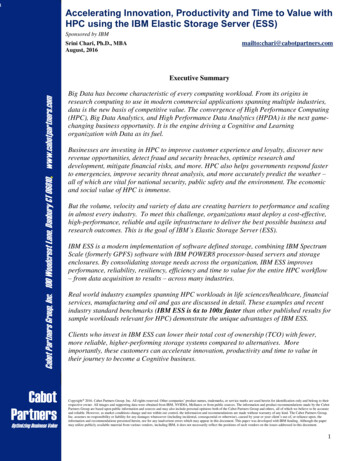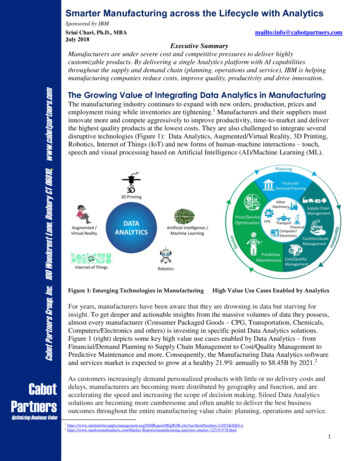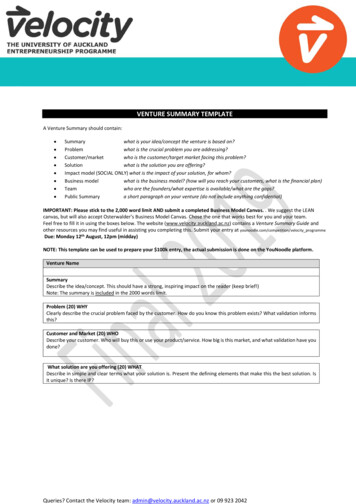
Transcription
aAccelerating Innovation, Productivity and Time to Value withHPC using the IBM Elastic Storage Server (ESS)Sponsored by IBMmailto:chari@cabotpartners.comSrini Chari, Ph.D., MBAAugust, 2016Cabot Partners Group, Inc. 100 Woodcrest Lane, Danbury CT 06810, www.cabotpartners.comExecutive SummaryCabotPartnersOptimizing Business ValueBig Data has become characteristic of every computing workload. From its origins inresearch computing to use in modern commercial applications spanning multiple industries,data is the new basis of competitive value. The convergence of High Performance Computing(HPC), Big Data Analytics, and High Performance Data Analytics (HPDA) is the next gamechanging business opportunity. It is the engine driving a Cognitive and Learningorganization with Data as its fuel.Businesses are investing in HPC to improve customer experience and loyalty, discover newrevenue opportunities, detect fraud and security breaches, optimize research anddevelopment, mitigate financial risks, and more. HPC also helps governments respond fasterto emergencies, improve security threat analysis, and more accurately predict the weather –all of which are vital for national security, public safety and the environment. The economicand social value of HPC is immense.But the volume, velocity and variety of data are creating barriers to performance and scalingin almost every industry. To meet this challenge, organizations must deploy a cost-effective,high-performance, reliable and agile infrastructure to deliver the best possible business andresearch outcomes. This is the goal of IBM’s Elastic Storage Server (ESS).IBM ESS is a modern implementation of software defined storage, combining IBM SpectrumScale (formerly GPFS) software with IBM POWER8 processor-based servers and storageenclosures. By consolidating storage needs across the organization, IBM ESS improvesperformance, reliability, resiliency, efficiency and time to value for the entire HPC workflow– from data acquisition to results – across many industries.Real world industry examples spanning HPC workloads in life sciences/healthcare, financialservices, manufacturing and oil and gas are discussed in detail. These examples and recentindustry standard benchmarks (IBM ESS is 6x to 100x faster than other published results forsample workloads relevant for HPC) demonstrate the unique advantages of IBM ESS.Clients who invest in IBM ESS can lower their total cost of ownership (TCO) with fewer,more reliable, higher-performing storage systems compared to alternatives. Moreimportantly, these customers can accelerate innovation, productivity and time to value intheir journey to become a Cognitive business.Copyright 2016. Cabot Partners Group. Inc. All rights reserved. Other companies’ product names, trademarks, or service marks are used herein for identification only and belong to theirrespective owner. All images and supporting data were obtained from IBM, NVIDIA, Mellanox or from public sources. The information and product recommendations made by the CabotPartners Group are based upon public information and sources and may also include personal opinions both of the Cabot Partners Group and others, all of which we believe to be accurateand reliable. However, as market conditions change and not within our control, the information and recommendations are made without warranty of any kind. The Cabot Partners Group,Inc. assumes no responsibility or liability for any damages whatsoever (including incidental, consequential or otherwise), caused by your or your client’s use of, or reliance upon, theinformation and recommendations presented herein, nor for any inadvertent errors which may appear in this document. This paper was developed with IBM funding. Although the papermay utilize publicly available material from various vendors, including IBM, it does not necessarily reflect the positions of such vendors on the issues addressed in this document.1
High Performance Storage Key to Extract Value from Data DelugeThe relentless rate and pace of technology-enabled business transformation and innovationare astounding. Several intertwined technology trends in Social/Mobile, Instrumentation andthe Internet of Things (IoT) are making data volumes grow exponentially. In 2018, about 4.3exabytes (1018 bytes) of data is expected to be created daily with over 90% unstructured.1By 2018, 4.3exabytes ofdata generateddailyTo extract timely insights from this growing data, it must be stored, processed and analyzed.But storing all this raw and derived data quickly, reliably, and economically for the longterm is very challenging. To generate valuable time-critical insights, it is also imperative toquickly prepare, analyze, interpret and keep pace with these rapidly growing data volumes.This requires faster, large-scale, cost-effective, highly-productive and reliable HighPerformance Computing (HPC) servers and storage. Today, large-scale HPC systems withclustered servers and storage are very affordable to acquire. This is spurring investments inHPC and High Performance Data Analytics (HPDA). Fueled by HPDA2, by 2019, the totalHPC market is expected to reach 31 billion.3 With 9.4% annual growth, the HPC storage4market is the fastest growing component, and is expected to reach 6.8 billion by 2019.At 6.8B in2019, Storageis the fastestgrowing HPCmarketcomponentClients across many industries – Healthcare/Life Sciences, Financial Services, Oil and Gas,Manufacturing, Media and Entertainment, Public Sector and others – are increasingly usingHPDA. These use cases integrate Systems of Records (structured data) with Systems ofEngagement (unstructured data – images, videos, text, emails, social, sensors, etc.) acrossmultiple organizational silos to produce new High Value Systems of Insights (Figure 1).Figure 1: High Value Insights from Integration and Analysis of Structured and Unstructured DataAs clients add more storage capacity (including Network Attached Storage – NAS), they arerealizing that the operating costs (including downtime and productivity loss) of integrating,managing, securing and analyzing exploding data volumes are escalating. To reduce thesecosts, many clients are using high performance scalable storage with parallel file systems.IBM ESSlowers TCOand improvesperformanceand reliabilityThe IBM Elastic Storage Server (ESS) is a leading high performance scalable storagesystem that combines IBM Spectrum Scale (an enterprise-grade, high performance parallelfile system) with IBM POWER8 processor-based servers and storage 016/02/06/how-much-data-is-created-daily/Earl Joseph, et. al., “IDC’s Top Ten HPC Market Predictions for 2015, January, 2015http://www.idc.com/getdoc.jsp?containerId on2016/EarlApril2016Meetingslides4.11.2016.pdf232
Many traditional HPC applications (seismic analysis, life sciences, financial services,climate modeling, design optimization, etc.) are becoming more data-intensive with higherfidelity models and more time-critical interdisciplinary analyses.IBM ESSenhancescollaboration,innovation andproductivity forHPC, Analyticsand CognitiveComputingNewer HPDA applications are also being used for cyber-security, fraud detection, socialanalytics, emergency response, national security, and more. Deep Learning (UnsupervisedMachine Learning leveraging HPDA) and Cognitive Computing are rapidly growingapplications that can significantly benefit from HPC infrastructure.Across many industries/applications, IBM ESS is helping clients enhance collaboration,innovation and productivity by optimizing HPC workflows across the entire data lifecycle.Considerations to Optimize HPC Workflows across Data LifecycleData volumes and access patterns intensify and vary widely as HPC applications, a crucialpart of time/mission-critical workflows across many industries, become more data-intensive.What took days to analyze in a pure research context must now be done reliably in hours orless, even as larger number of projects and files must be tracked.Storage architecture decisions are crucial to optimize the Total Cost of Ownership (TCO) forthe entire collaborative workflow from data acquisition to data preparation to analysis andvisualization/interpretation. Key considerations to enhance productivity and innovation are:Storage mustbe optimizedfor entire dataworkflow fromacquisition tovisualization/interpretation Data Location and Movement: As data volumes grow exponentially, the costs of movingthe data in and out of a compute processor becomes prohibitive. To move 1 byte fromstorage to the central processor, it could cost 3-10 times the cost of one floating pointoperation (flop).5 So, it is imperative to keep the frequently used active data on a highperformance storage system close to the processor. This minimizes data motion andreduces access overheads especially when reusing the same data. Applications/Workflow Performance: After the raw data is acquired, it is typicallyconsolidated, prepared and analyzed by multiple automated applications and analysisworkflows working in tandem with end users; typically increasing the active data size byseveral-fold. These larger datasets must be processed on the hundreds of compute cores ina cluster. This means that the storage systems must perform and be able to feed these coresto keep the workflows operating at full-throttle. Active and Archive Data: Once data passes into the archive tier as part of a repository, it isimportant to quickly access data and metadata when needed, regardless of where it is andwhich operating system is requesting the file. Data Security, Privacy and Protection: How secure and private is the data? Is data storedin a redundant manner to ensure rapid recoverability? How much control does the userhave over remote storage? These are especially critical in many commercial settings thathave stringent regulatory compliance requirements.Data curity andprotection keyconsiderationsAlso, as disk drives become increasingly denser, traditional RAID is no longer an effectivemechanism for data protection since it can take from several hours or even days to rebuild afailed drive, which can increase the chance of multi-disk failures.The IBM Elastic Storage Server (ESS) can address many of the above challenges and lications/2010/ShalfVecpar2010.pdf3
IBM Elastic Storage Server (ESS) OverviewIBM ESS is amodern, highperformancesoftwaredefined storagesystemCombines IBMSpectrum Scaleparallel filesystem withPower Systemsfor highperformanceand reliabilityIBM ESSreducesinefficiencyand acquisitioncosts whileimprovingsystemsmanagementand dataprotectionIBM Elastic Storage Server (ESS) is a modern implementation of software defined storage,combining IBM Spectrum Scale (formerly GPFS) software with IBM POWER8 processorbased servers and storage enclosures. Spectrum Scale is a widely used high-performanceclustered/parallel file system that eliminates silos and simplifies storage management. It canbe deployed in shared-disk or shared-nothing distributed parallel modes; providingconcurrent high-speed file access to applications executing on multiple nodes of clusters.Key Spectrum Scale features include: POSIX file system makes it easier to build workflows that include diverse workloads anddata. Easier and quicker sharing and ingestion of data Faster file system performance that translates to workload acceleration through nativeexploitation of high performance networks Run Analytics in-place: The built-in Hadoop connector allows running Hadoop analyticsin-place i.e. no need to copy data to HDFS to run Hadoop applications Encryption and secure deletion functions adds more security Distributed metadata server prevents a single point of failure and provides betterperformance than a single name node Automated data management features like, Active File Management (AFM), InformationLifecycle Management (ILM), and Multi-cluster promotes collaboration and improvesoperational efficiency Access controls (ACLs) allow better security control of data between multiple tenants in ashared infrastructure environment.By consolidating storage requirements across the organization, IBM ESS reducesinefficiency and acquisition costs while simplifying management and improving dataprotection. Key features include: Software RAID: Runs IBM disks in a dual-ported storage enclosure that does not requireexternal RAID storage controllers or other custom hardware RAID acceleration Declustering: Distributes client data, redundancy information and spare space uniformlyacross all disks of a JBOD – Just a Bunch of Disks. This reduces the rebuild or disk failurerecovery process time compared to conventional RAID. Critical rebuilds of failed multiterabyte drives can be accomplished in minutes—rather than hours or even days withtraditional RAID Data redundancy: Supports highly reliable 2-fault-tolerant and 3-fault-tolerant ReedSolomon-based parity codes (erasure coding) as well as 3-way and 4-way replication Large cache: Using a combination of internal and external flash devices along with theIBM Power server’s large memory cache, ESS is better able to mask the long latencies andinefficiencies of nearline SAS drives, while still leveraging these high density drives Intuitive Graphical user interface (GUI): Allows management and monitoring of thesystem, both locally and remotely Superior streaming performance: Delivers over 25 GB/second of sustained performance Scalability: As server configurations are added to an installed configuration, the capacity,bandwidth, performance and single name space all grow. This means installations can startsmall, and grow as data needs expand.A more detailed, industry-specific discussion follows. It highlights: the key industry trends,storage/data management challenges and how IBM ESS addresses these issues.4
Overcoming Data Challenges in Life Sciences/HealthcareAll stakeholders in the healthcare/life sciences ecosystem – providers, payers, governments,biopharmaceutical companies, clinical research organizations (CROs), medical device anddiagnostic firms, employers, and other public health organizations – are collaborating ininnovative ways to drive better outcomes for the individual patient. Figure 2 describes thisecosystem and the substantial impact of a range of HPC disciplines. We detail key industrytrends, storage/data management challenges and how IBM ESS overcomes these obstacles.Healthcare /Lifesciencesecosystemcollaboratingto drive betterpatientoutcomesKey Life Sciences Trends. Rapidly declining gene sequencing costs, advances in recordingtechnology and affordable clustered compute solutions to process ever larger datasets istransforming life sciences research. Today, a human genome can be sequenced within a day6and for about 1000, a task that took 13 years and 2.7 billion to accomplish during theHuman Genome Project.7 Likewise, data from light-sheet fluorescence microscopy (LSFM)can be analyzed to relate neuronal responses to sensory input and behavior. These analysescan run in minutes on clusters8, turning brain activity mapping efforts into valuable insights.A humangenome can besequencedwithin a dayfor about 1000Figure 2: Healthcare/Life Sciences Disciplines/Industries (Red) Benefit from HPCBy 2025, the economic impact of next-generation sequencing (NGS) and related HPCtechnologies (Figure 2) could be between 700 billion to 1.6 trillion a year. Bulk of thisvalue results from the delivery of better healthcare through personalized and translationalmedicine. NGS enables earlier disease detection, better diagnoses, discovery of new drugsand more personalized therapies. But it is crucial to overcome storage/data challenges.By 2025, theeconomicimpact of HPCin Life Sciencescould be up to 1.6 trillion ayearKey Healthcare Industry Trends. Each person is expected to generate one milliongigabytes of health-related data across his or her lifetime9, the equivalent of more than 300million books. McKinsey estimates that if the US health care system were to use Big DataAnalytics creatively and effectively to drive efficiency and quality, the potential value ment-Final.pdf8Jeremy Freeman, et. al., “Mapping brain activity at scale with cluster computing”, Nature Methods, July se/46580.wss5
healthcare data could be worth more than 300 billion every year, two-thirds of which wouldbe in the form of reducing national health care expenditures by about 8 percent.As Electronic Medical Record (EMR) systems become more affordable and widespread,data can be exchanged more easily. Recent advances in software are also making it simplerto cleanse data, preserve patient privacy and comply with Health Insurance Portability andAccountability Act (HPPAA). But there are still many obstacles with compiling, storing andsharing data reliably with high-performance and security.Declining costsof life sciences/ healthcaredatageneration isdriving storagerequirementsLife Sciences/Healthcare Storage and Data Management Challenges. The rate of growthof genomics and imaging data continues to explode. For instance, the Illumina HiSeq X TenSystem – designed for population-scale whole genome sequencing (WGS) – can processover 18,000 samples per year at full utilization. Each HiSeq X Ten System generates up to1.8 terabytes (TB) per run. When the HiSeq X Ten System operates at scale, it can generateas much as 2 petabytes (PB) of persistent data in one year.Similarly, new technologies based on imaging and multi-electrode arrays are making itpossible to record simultaneously from hundreds or thousands of neurons and for someorganisms, nearly the entire brain. For example, an hour of two-photon imaging in mousecan yield 50–100 gigabytes (GB) of spatiotemporal data, and recording from nearly theentire brain of a larval zebrafish using light-sheet microscopy can yield 1 TB or more.2But storagecosts are notdeclining asfast as datagenerationcostsAs the cost of sequencers and imaging instruments become more affordable, smallerinstitutions are increasingly deploying them. Even larger existing research organizations arepurchasing more instruments. This only compounds the growth of distributed raw data. Rawdata must be consolidated, aligned and packaged; making storage requirements even greater.Unfortunately, storage costs are not declining as fast as sequencing costs.10 Estimates arethat in 2025, 2 to 40 Exabytes (EB) will be required just for the human genomes.11To provide higher value insights and holistic patient-centric healthcare, information acrossmany data pools (claims, clinical, behavioral, genomic, imaging, etc.) must be rapidlyintegrated and analyzed. This requires a common high-performance, cost-effective analyticalplatform with low storage acquisition costs especially as data volumes continue to explode.But many life sciences/healthcare organizations need are also realizing that the operatingcosts (including downtime and productivity loss) of managing, securing, tracking andcleansing these exploding volumes of data are growing even more. These organizations alsoneed a storage solution that provides the bandwidth to scale to very large data volumes andallows users to collaborate across geographies within single name space.IBM ESSprovides acost-effective,scalable. highperformancestorage forcollaborativelife sciencesThe IBM ESS solution. It provides high performance (throughput) possible with native fileaccess using POSIX client that traditional NFS or Scale-out NFS cannot match. In addition,Active File Management (AFM) enables global collaboration in a single name space.Based on the POWER8 processor, ESS is a turnkey integrated solution that is quick todeploy, and is one hundred percent implemented in software and using standard servers andJust a Bunch of Disks (JBOD). This helps reduce the TCO compared to osts/Zachary D. Stephens, et. al., “Big Data: Astronomical or Genomical?” PLOS Biology, 2015.6
IBM Systems provide fast data ingestion rates from storage and superior performance toaccelerate the entire workflow because of the unique architectural attributes of thePOWER8: larger number of threads, greater memory size and bandwidth, higher clock ratesand support for a Coherent Accelerator Processor Interface (CAPI).IBM Systemscan complete65x coverageof the wholehuman genomeFor example, Burrows-Wheeler Aligner (BWA) is an efficient NGS program that alignsrelatively short nucleotide sequences against a long reference sequence such as the humangenome. With Power Systems and ESS, it is possible to complete 65x coverage of the wholehuman genome using the Broad Institute’s best practice pipeline consisting of BWA andother genomic tools (Samtools, PICARD, GATK) in less than 20 hours.Addressing Data Management Challenges in Financial ServicesBanks and Insurance companies are under intense pressure to cut costs yet improve thequality, accuracy and confidence of risk assessment. Integrated Financial Risk Analytics hasbecome a core and pervasive part of these firms (Figure 3). Key industry trends, storage/datamanagement challenges and how IBM ESS overcomes these obstacles are detailed here.Integrated RiskAnalytics iscore andpervasive atFinancialServices firmsFigure 3: Better Outcomes with Vertical and Horizontal Integration of RiskKey Trends. Increasingly, financial firms must adhere to an avalanche of stringent andcomplex regulatory requirements. Regulators now require tighter supervision of model riskmanagement and are carefully dissecting failures from inadequately managing risk.Active riskmanagementcrucial forcompetitiveedgeBesides traditional quantitative risks such as credit, market and liquidity risks; qualitativerisks such as operational, reputation and strategic business risks are increasingly becomingimportant12. Consequently, CEOs increasingly rely on their CFOs and Chief Risk Officers(CROs) for strategic advice and active risk management13 to gain a competitive edge.In the past, many firms analyzed risk in silos or using ad-hoc approaches without structuredgovernance processes. But now, with recent Basel III, Solvency II and Dodd Frankregulations aimed at stabilizing financial markets after the global financial crisis, firms havestrong incentives to improve compliance so as to reduce capital requirements and reserves.Chartis, “The Risk Enabled Enterprise – Global Survey Results and Two Year Agenda”, tl03273usen/YTL03273USEN.PDF13Pushing the frontiers: CFO insights from the IBM Global C-suite Study, 2014, 590usen/GBE03590USEN.PDF127
More than 2/3rd of losses sustained by financial firms between 2008 and 2011 were due toCredit Value Adjustment (CVA) mismatches14 rather than actual defaults. So, many leadingfirms are empowering their traders with investments in real-time risk analytics for bettertrading outcomes; extending their risk management operations from traditional end-of-dayValue-at-Risk (VaR) reporting in the middle office to decision support in the front office.Pioneeringfirms investingin front-officereal-time RiskAnalytics thatchallengetraditionalsiloed storageThe level of sophistication of risk models varies widely from relatively simple spreadsheettools to complex mathematical models that can scale to thousands of economic scenarios andinstruments. Complex real-time risk analytics pose many storage and data challenges.Data/Storage Management Challenges. Many legacy risk systems are often ad-hoc and insilos, and cannot scale to handle the increased volume and frequency of analyses nowdemanded by regulators. The need to consistently apply accurate risk insights in makingtimely decisions throughout the enterprise is driving firms to improve standardize riskframeworks, consolidate risk systems, combine insights and share IT infrastructure.The infrastructure must support a combination of large-scale compute and data-intensiveanalytics with real-time batch workloads. It must be reliable, flexible, agile and highperformance without overloading networks or letting costs go out of control.The IBM ESS solution. It accelerates business results and delivers fully simulated near–real-time risk assessments. This innovative enterprise-grade, high-performance parallelstorage solution allows users to right-size compute and right-place storage resources basedon the importance and time-criticality of each analytic job.IBM ESSdelivers veryreliable, highperformanceshared storageIt is fully POSIX compliant (so can run Analytics in-place instead of copying data to adifferent platform), delivering very high performance with no single point of failure andmaintaining business continuity. Each compute node gets fast parallel read/write access to acommon file system to accelerate the job.IBM ESS dramatically improves simulation performance by avoiding filer “hot spots”common in network file sharing (NFS) or Server Message Block (SMB) file-sharingimplementations. Fast parallel file system access is critical to speed up aggregation steps inrisk analytics and also helps improves query performance.It also provides efficient block-level data replication between multiple clusters in the samedata center or in a remote center. Current data sets that are replicated between centers notonly ensure business continuity if one center is unavailable, but also provide additionalcapacity to help meet periods of peak demand.Eliminate dataand computebottleneckswhile ensuringbusinesscontinuityFor example, major banks and insurance companies have seen dramatic reductions inaggregation time by replacing the traditional filers with ESS and increasing the data transferspeeds from compute hosts to shared storage. ESS eliminates compute and data bottlenecksby providing an independent path between compute nodes and storage to speed up datamanagement – up to 10x improvement in raw file system I/O and 2x increase in scenariomodeling capacity.14http://www.shearman.com/ eforOTCDerivativeTradesFIAFR111113.pdf8
Financial firmsget a full reporton all riskexposures ontime every dayThis provides a very agile and scalable risk system, enabling analysts with on-demandcapabilities for rapidly developing, testing, and deploying risk models while significantlyimproving overall system efficiency by effective sharing of critical resources. Firms can nowreliably get a full report on their risk exposures on time every day. Mirrored data volumes toa second site can provide the business continuity critical to banks and insurance companies.Solving Engineering Simulation Data Management ChallengesMany stakeholders in the manufacturing ecosystem – Automotive, Aerospace, Electronicsand Heavy Industry, Suppliers, Governments and Academia – are collaborating to design anddevelop safer and better products. Figure 4 portrays how HPC applications in disciplines likestructures, fluids, crash and design-optimization benefit manufacturing. We detail keyindustry trends, storage/data management challenges and the IBM ESS value proposition.EngineeringSimulation keyto enhancemanufacturer’sproduct qualityand reliability,productivity,innovation andprofitabilityFigure 4: Manufacturing Industries/Disciplines (Red/Orange) Benefit from HPCMechanical Computer Aided Engineering (MCAE) Trends. Today’s productdevelopment environment is global, complex and extremely competitive. Businesses race toimprove product quality and reliability and to reduce cost and time-to-market to grow marketshare and profits. Complex cross-domain simulation processes must integrate with designthroughout the product lifecycle. These realistic high-fidelity multidisciplinary simulationsdrive remarkable product innovation but cause a data deluge.Must quicklyextract insightsfrom largepetabytes ofsimulationresults dataFor instance, a single data set of Computational Fluid Dynamics (CFD) results, from onesimulation, could run into 100s of gigabytes. During production analysis, when many suchCFD simulations are necessary, these results can quickly aggregate to 100s of terabytes oreven a few petabytes. Managing and drawing actionable business insights from this Big Datarequires enterprises to deploy better data/storage management and simulation/analysisapproaches to extract business value. This is critical to drive innovation and productivity.Electronic Design Automation (EDA) Trends. A wide range of EDA solutions are used tocollaboratively design, test, validate, and manufacture rapidly shrinking nanometer integratedchips leveraging advanced research, process technologies, and global R &D teams.9
Predictiveanalytics usingsemiconductorphysics’ firstprinciples driveup data sizesToday, Static Timing Analysis (STA) for circuit simulation and Computational Lithographyfor process modeling are key HPC applications. The ultimate goal for many semiconductorR&D enterprises is to virtualize the full semiconductor development process. Doing so couldreduce cost by requiring fewer silicon experiments and improving time to market for nextgeneration semiconductor technologies. But these new predictive analytics applicationsbased on near first principles of semiconductor physics could further drive up data volumes;placing even greater demands on HPC servers and storage.Data/Storage Management Challenges. Engineering simulation data differs from otherproduct design data in
costs, many clients are using high performance scalable storage with parallel file systems. The IBM Elastic Storage Server (ESS) is a leading high performance scalable storage system that combines IBM Spectrum Scale (an enterprise-grade, high performance parallel file system) with IBM POWER8 processor-based servers and storage enclosures.










